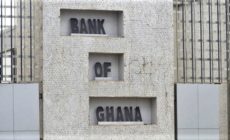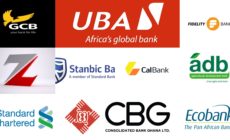Almost all the banks that have released their quarter one financial statements show impressive results.
As usual, Ghana’s biggest bank Ecobank Ghana recorded a growth rate of 14.48 per cent in profit of GH¢85 million in the first quarter of 2017.
Return on equity was high at 34.88 percent, signaling good returns for shareholders.
The balance sheet remained strong with customer deposits at GH¢5.6 billion in quarter one 2017, as against GH¢4.4 billion in quarter one 2016.Loans and advances to customers remained high at GH¢3.2 billion in quarter one 2017.
While capital adequacy ratio stood at 15.49 percent, non-performing loans had shot up from 16.80 percent in quarter one to 17.53 percent in quarter one 2016.
HFC Bank, and its subsidiaries increased its profit (before tax) by 17.5 per cent from GH¢11.3million within the first quarter of 2016 to GH¢13.37million for the same period.
Customer deposits rose from GH¢1.2billion in the same period under review in 2016 to GH¢1.55billon in 2017, representing an increase of 29 per cent.
Barclays Bank Ghana also posted some sterling results as profit went up by 77.6 percent to GH¢96 million at the end of March 31, 2017.
Customer deposits stood at GH¢2.9 billion in March 31, 2017, from GH¢2.3 billion in March 31, 2016.
It remained one of the well capitalised bank with stated capital of GH¢115 million and an income surplus of GH¢421 million.
Whilst capital adequacy stood at 20.92 percent in quarter one 2017, an improvement over the March 31, 2016 figure, its NPL ratio was 15.98 percent, better than the March 2016 figure of 20.63 percent.
Another tier-one bank, Standard Chartered Bank recorded a 17.9 percent increase in profit of GH¢83.6 million for the first three months of this year. At the same time, its net interest income, including interest from loans and investments increased from GH¢102 million in March 31, 2016 to GH¢116 million in March 31, 2017.
However, its fees and commission income went down from GH¢28.5 million in quarter one 2016 to GH¢18 million in quarter one 2017.
Though it NPL ratio has declined, it remained still high at 42.83 percent. The capital adequacy was, however, strong at 32.28 percent at the end of the first quarter of 2017, compared with 19.43 percent during the same period last year.
Continuing with the good financial performance, Zenith Bank registered a profit of GH¢42 million in quarter one 2017 as against GH¢31 million in quarter one 2016.
Also, a top-tier bank, deposits from customers had witnessed significant growth, from GH¢1.8 billion in March 31, 2016 to GH¢2.5 billion in March 2017.
It also remained one of the liquid banks with capital adequacy ratio of 23.62 percent in quarter one 2017 and a low NPL ratio of 10.08 percent at the end of March 31, 207, a reduction from the 10.37 percent registered in quarter one 2016.
On the other hand, another tier one bank Stanbic Bank recorded virtually unchanged profit of GH¢45 million at the end of the first quarter of 2017. Deposits from customers also did not witnessed growth and stood at GH¢3.5 billion.
Its NPL however declined from 22.06 percent in the first quarter of 2016 to 13.60 percent in quarter one 2017, whilst capital adequacy ratio stood at 18.92 percent in March 31, 2017, compared with 14.92 percent in March 31, 2016.
FBN, UBA and Access Bank Ghana all recorded some improved and good financial performances for the first quarter of 2017.
The banking industry in Ghana returned to profitability during the first two months of 2017 following a 15.9 percent growth in their bottom line, according to the Financial Stability Report by the Bank of Ghana. Net profit after tax increased to GH¢366.7 million in February 2017 from GH¢316.3 million in February 2016.
Annual growth in banks’ net interest income also picked up from 14.6 percent to 17.8 percent during the same comparative periods. Interest income from loans constituted 44.7 percent of total income in February 2017 compared with 49.2 percent in February 2016.
Bank’s share of investment income in total income increased to 38.6 percent in February 2017 from 32.6 percent in February 2016.











 (Selorm) |
(Selorm) |  (Nana Kwesi)
(Nana Kwesi)